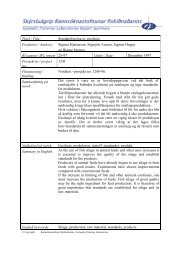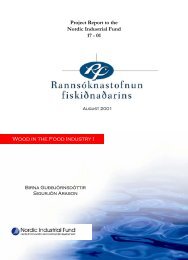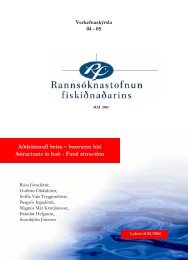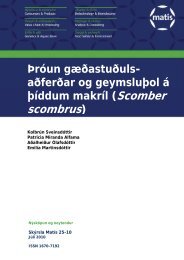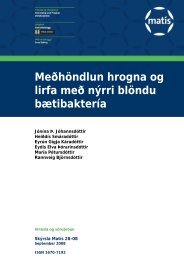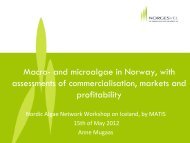Microbiology and Spoilage Trail in Nile Perch (Lates niloticus), Lake ...
Microbiology and Spoilage Trail in Nile Perch (Lates niloticus), Lake ...
Microbiology and Spoilage Trail in Nile Perch (Lates niloticus), Lake ...
You also want an ePaper? Increase the reach of your titles
YUMPU automatically turns print PDFs into web optimized ePapers that Google loves.
The results from chilled fillets (figure 27) from all four establishments show similar trends<br />
on both spoilage microflora <strong>and</strong> TVB-N. Changes <strong>in</strong> the spoilage micro flora on all chilled<br />
fillets dur<strong>in</strong>g storage, <strong>in</strong>itially were 3-4log10cfu/g <strong>and</strong> at the end of storage time were ≥8-<br />
9log10cfu/g (5 <strong>and</strong> 6 days <strong>in</strong> ice) <strong>and</strong> ≥10log10cfu/g (10 <strong>and</strong> 17 days <strong>in</strong> ice) respectively. The<br />
changes <strong>in</strong> total volatile base nitrogen (TVB-N) were from 10-21mgN/100g, the values were<br />
well below the maximum limits of 30-35mgN/100g of acceptability of fresh fish. The trends<br />
<strong>in</strong> SSO <strong>and</strong> TVC counts are better than Enterobacteriaceae <strong>and</strong> TVB-N imply<strong>in</strong>g that are<br />
good <strong>in</strong>dicators for mak<strong>in</strong>g decision of freshness quality of chilled fillets stored at low<br />
temperatures (0-3 o C).<br />
Figure 27: Chilled fillets from establishments<br />
4.4 PRESUMPTIVE SSOs<br />
At the end of storage time for whole <strong>Nile</strong> perch <strong>and</strong> chilled fillets, few colonies from plates<br />
of IA <strong>and</strong> VRBGA were confirmed. Most colonies results were Gram-negative, rod shaped,<br />
oxidase positive, catalase positive, <strong>and</strong> Hugh <strong>and</strong> Leifson (O/F – fermentative <strong>in</strong> glucose).<br />
Few colonies were oxidase/catalase negative <strong>and</strong> non fermentative <strong>in</strong> glucose. The<br />
Enterobacteriaceae colonies from VRBGA also were Gram-negative, rod shaped, oxidase<br />
negative, catalase positive, <strong>and</strong> Hugh <strong>and</strong> Leifson (O/F – fermentative <strong>in</strong> glucose). These<br />
results imply that the ma<strong>in</strong> SSO (H2S) on iced whole <strong>Nile</strong> perch <strong>and</strong> chilled fillets may be<br />
caused by Shewanella putrefaciens, Pseudomonas, Vibrios/Aeromonas <strong>and</strong><br />
Enterobactericeae (figure 28).<br />
56




